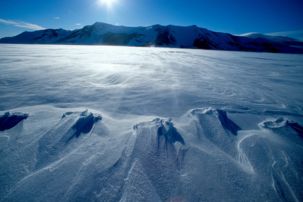Lesson summary
In this activity students investigate what happens when rising temperatures cause ice on land and in the sea to melt. They conduct two experiments, one looking at sea ice and the other looking at land ice and observe how the melting of this ice affects the sea level.
Learning intentions:
Students will...
- understand the difference between sea ice and land ice
- recognise that melting land ice will affect sea levels, but that melting sea ice won’t cause as much of a rise in sea levels
- understand that simple science experiments can be used to demonstrate these differences clearly.
Lesson guides and printables
Lesson details
Curriculum mapping
Australian curriculum content descriptions:
Year 3 Science:
- A change of state between solid and liquid can be caused by adding or removing heat (ACSSU046)
- With guidance, identify questions in familiar contexts that can be investigated scientifically and predict what might happen based on prior knowledge (ACSIS053)
- Compare results with predictions, suggesting possible reasons for findings (ACSIS215)
- Reflect on the investigation, including whether a test was fair or not (ACSIS058)
Year 4 Science:
- With guidance, identify questions in familiar contexts that can be investigated scientifically and predict what might happen based on prior knowledge (ACSIS064)
- Compare results with predictions, suggesting possible reasons for findings (ACSIS216)
- Represent and communicate ideas and findings in a variety of ways such as diagrams, physical representations and simple reports (ACSIS071)
Syllabus Outcomes: ST2-12MW, ST2-4WS.
Time required: 60 mins.
Level of teacher scaffolding: High – conduct experiment, facilitate discussion and oversee activity
Resources required
- Ice cubes
- Waterproof tray
- Plastic sheet
- Sticky tape
- Scissors, water
- Black marker
- Ruler long enough to fit most of the width of the tray
- Gravel (optional)
- Internet access
- Student worksheet
Additional Info
This is an original Cool.org lesson. Facts and figures in these lessons may have changed since this lesson was published. We always endeavour to update our resources in a timely manner, but if you see an error or issue in our resources please get in touch with us.


Welcome back!
Don't have an account yet?
Log in with:
By signing up to Cool.org you consent and agree to Cool's privacy policy to
store, manage and process your personal information. To read more, please see
our privacy policy here(Opens in new tab).
Create your free Cool.org account.
Many of our resources are free, with an option to upgrade to Cool+ for premium content.
Already have an account?
Sign up with:
By signing up to Cool.org you consent and agree to Cool's privacy policy to
store, manage and process your personal information. To read more, please see
our privacy policy here(Opens in new tab).